The Outforce Preview
Can The Outforce compete with more technologically-advanced real-time strategy games?
While more and more real-time strategy games have been trumpeting their full 3D environments and complex unit tactics, O3 wants to shift the focus of The Outforce back to the hallmarks of the traditional real-time strategy game - an overhead view of a 2D battlefield and simple point-and-click combat. O3 is betting that a stripped-down formula of harvest, build, and kill is what made RTS games popular in the first place and what will help The Outforce succeed in a crowded genre. In emphasizing established gameplay concepts over novelty, The Outforce pays more than a passing nod to its science-fiction RTS forebears like Total Annihilation and, especially, Starcraft. Again, three races battle for supremacy in space. There are two resources to be harvested, there's an attempt to give each unit type an individual character through unique voice responses, and there are also some unusual new features added to the mix.
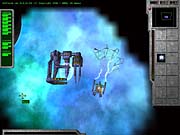
Set in the 25th century, The Outforce has humans fleeing Earth after a devastating asteroid strike. While seeking refuge among the stars, they stumble upon two races that have been bitterly warring for centuries, the aggressive turtle-like Gobins and the proud warriors of the Crion Empire. A series of campaign missions begins with you as the humans, who are sent to investigate the disappearance of a Babylon 5-like space station that serves as a neutral meeting ground for Crion and Gobin ambassadors. This story, though, really just seems to be the obligatory backdrop, since the missions instead focus on basic combat goals like destroying enemy outposts or retrieving stolen fusion reactors. O3 doesn't let the plot get in the way of the story, so to speak. There isn't an emphasis on characters to emotionally relate to or a complex plot twist to draw you into the story.
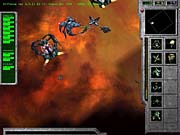
In keeping with its classic design, The Outforce takes place in a 2D environment with cosmetic touches that give a partial illusion of 3D depth. Thanks to a particularly arresting effect, units seem to float over stellar clouds; it's reminiscent of looking down through a glass-bottomed boat. You can pan the camera with the mouse, as well as rotate and zoom with the keyboard, although it would likely be easier and more intuitive to have all these commands available from the mouse. You can also change camera elevation angle from the keyboard, but only slightly: At its heart, The Outforce sticks to the proven top-down RTS view. Because of this, the maps give the superficial appearance of an outer-space environment, but they have to rely on asteroid fields, planets, massive space platforms, and alien defensive barriers (imagine enormous high-tech picket fences in space) to funnel units and create tactical challenges. The effect is a bit disconcerting at first, but you quickly adapt to it.
Overview
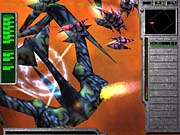
The game's core concepts will be familiar to just about any RTS player. You start with a central command module, and from there you build your basic units, in this case the fast but weak drone fighter, a towship for moving modules inside your defensive perimeter or hauling captured units, and a constructor for building new modules and repairing damaged units. Your first order of business is to harvest resources. The power needed for your processing plants and modules to function comes from solar power stations you erect with your constructors. To harvest metal for building ships, you create metal-processing modules. In an interesting twist on harvester units, these modules spawn single autonomous drones that head off in search of the nearest resources - you don't even have to lift a finger. When the collector is filled to capacity, it returns the module on its own to deposit its newfound wealth. This saves you from the frequent RTS hassle of shepherding and micromanaging resource gatherers.

Resource management consists of constantly balancing your harvesting and expenditures of metal and energy, which is very much in the fashion of Total Annihilation's system. This is made easy by a control panel readout on the right side of the screen that shows your current resource balance, resource storage capacity, and how much you currently have on hand. There's also a graphic power gauge that shows power consumption in red and power input in green. Of course, when you're totally immersed in furious battle, you'll be hard pressed to keep glancing at these readouts, but to help you, there's a disembodied female voice that warns you of critical resource deficits. Should your power balance tip into the negative, you'll get constant audible warnings about the situation. In fact, these can get a little too constant, but you have the option to turn them off.
In this same control panel, you'll see an individualized build queue for your currently selected module. You're presented with images of each available unit at your current stage in the game, and to build, you simply click on the unit you want. One left-click adds a unit to the queue, and one right-click removes a unit. There's an indicator that shows both the progress on the current unit and the number of units left in the queue. When you intend to build something other than a ship, such as a laser defense turret or new module, you simply click on the image in the control panel and drag a box outline to the desired location. If it's white, you can build it there, but if there's not enough room, the box stays red and prevents you from building. Like the resource readouts, building indicators and commands form an elegantly simple system; the designers keep all vital information in one corner of the screen for easy reference.
Controlling the Game

Unit selection is a breeze. You select groups of ships with a bandbox or shift-click and then easily assign them to a squad. You can also select all units of one type with a single hotkey. Tired of losing critical units? Your camera can track a selected ship as well. There's a context-sensitive cursor for orders: If you place it in an empty space and click, the selected unit will move there; if you place it over an enemy, you can click to attack. You can easily queue multiple orders, and in a refreshing change from some RTS games, you can also issue orders while the game is paused. A Quake-style console, which you can access to tweak game variables and create scripts for automating unit tasks, should prove to be one of The Outforce's most interesting features.
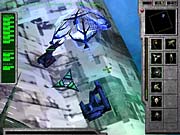
You can set ships to guard other units or to swoop around an area in a patrol pattern. Other than that, you can't set them into specific formations, facings, or combat stances like aggressive or defensive. Tactics are more a question of moving significant numbers of the right unit against correspondingly weak enemy craft. Units themselves typically have only one indicator to worry about: health, in the form of a bar that appears in the right control panel readout. Ammo counts are generally unlimited; just send your ships into the fray, and they'll pack enough punch. While you can of course select specific targets, your ships will blast right back on their own if they come under fire. As with harvester units, you don't need to micromanage, although pathfinding is a bit buggy at this stage.
The missions stick to basic combat goals. Starting with fundamental structures, you build up your fleet from scratch. New structures lead to new build trees, which means more powerful ships for dealing out death and destruction. You'll need more resources for these, so you're always balancing resource collecting, building, and fighting. In a sense, the game is about basic supply and demand as much as fighting. Hunting for more metal is always an adventure with the full fog-of-war effect on, since anything outside a small area around your units is inky black. As you move into the unknown, the area around your exploring ships brightens, and previously explored areas (where you don't have a fleet presence) are left gray. Once you reach the mission's targets, combat plays very quickly at the default speed setting, and it takes lightning reflexes to keep your units organized. Luckily, there are variable speeds and the handy pause command. The missions don't just wait for you to come to the enemy, though, since scripting ensures they'll come to you when you least want them to. In addition to these scripted missions, there is also a full skirmish mode and varied multiplayer modes over the Internet or a LAN.
Final Thoughts
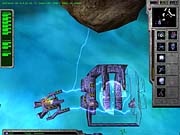
Stylish graphics bring the action to life. The prerendered intro movie and cutscenes are vibrant and exciting, though the dialogue tends to get buried beneath the music and sound effects. The in-game graphics are highlighted against gorgeous stellar backdrops, and the animated units tend to be quite colorful themselves. Harvesters suck up resources in streams of energy. New human modules appear as wireframe models, and constructors envelop them in blue energy discharges as they're built up before your eyes. Ships scatter bits of debris as they glide out of the gantries of construction facilities. While the 3D units look nice, there's one bit of concern: A number of units from different races look rather similar at first glance, especially when you zoom out far enough to get a useful overall view of the battlefield.
Backing the visuals is an ambient and techno soundtrack. While it would be nice to hear the beat pick up when combat starts and then slacken when battle is done, some of the tracks are nevertheless really beautiful, with their dark and ethereal brooding. The final build should feature an MP3 player that you can customize with your own playlist. So far, many of the unit combat sound effects are a bit on the bland side compared to the music. But, to give each unit a recognizable character, ships will talk back to you in different accents and tones of voice whenever you select them. In a bit of homage, the human tow ship sounds eerily similar to the hillbilly Terran Siege Tank commanders of Starcraft. Also very reminiscent of Starcraft, the organic Gobin units emit guttural Zerg-like hisses when you select them.

These characteristic voices contribute to the core concept of three distinct yet balanced races. Of the 120 units, there are unique ones like the gravity repeller and antiwarp generator. Nevertheless, each race has many units that perform similar functions and have about the same firepower and health, but they still evince their own quirky individual style. Some of the high-tech Crion modules unfold delicately as they're being built and transform into airy greenhouselike structures. The organic Gobin ships burst out of their modules like reptiles from eggs, with an appropriately gross sound effect. As a Gobin construction ship creates a new structure, it sends out a massive umbilical shoot that gives birth to a writhing, deformed egg that expands and pulsates until it hatches a new station.
It's clear where The Outforce gets it inspiration from. The ghosts of Starcraft and Total Annihilation hover palpably over the game. The designers don't seem to be set on just imitating the classics, though, as there are some interesting twists added to time-tested RTS conventions, and some of the units and graphic effects are quite colorful. The pseudo 3D backgrounds are stunning, and some of the music is equally impressive. It will be interesting to see how this real-time strategy game, which includes unusual new features, stacks up to its fierce competition.
Got a news tip or want to contact us directly? Email news@gamespot.com
Join the conversation